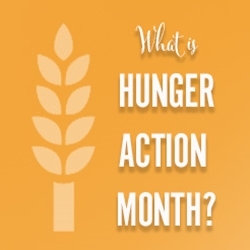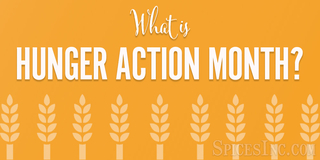What is Hunger Action Month?

Hunger action month is an event that takes place during the month of September to bring awareness to hunger and food insecurity in America. More than 40 million Americans, or just about 13% of the population, struggle with food insecurity every year. This number is continually rising. Food insecurity is defined as the inability to access affordable, nutritious food regularly. This can mean you are living off a diet that mainly consists of food with little to no nutritional value, or you are consistently unsure of where your next meal will come from, regardless of its health benefits. Of all the people in food insecure households, the hungriest are children. The most obvious cause of hunger in America is poverty. This effects people of all age groups, but children and seniors are often the most impacted by poverty.
Hungry Kids in Food Insecure Households
The United States is one of the wealthiest countries in the world and yet still 1 in 5 children will go hungry this year, while that likelihood rises to 1 in 3 for children of African American and Latino families. Hungry children are often distracted, exhausted, and disinterested in anything that isn't "when will I eat next?" These hungry children are also more likely to develop sicknesses or illnesses because of compromised immune systems from their poor nutrition that would lead them to miss school. A few days here or there can add up over time, meaning gaps in education. This becomes problematic because access to less education can translate to access to a better paying job that may help them gain the resources to get out of poverty, and so the cycle continues.
A Different Kind of Hunger
When Americans think about hungry people, they often imagine sickly thin folks, lying helplessly on beds in rooms of varying degrees of disarray. They imagine bare houses, bare cupboards, and no appliances. This is often not the look of today's hunger. Today's hunger might have housing with a vehicle and sometimes even a fancy cell phone and all the technologies the modern world can offer.
As technologies increase, the desire and need to have them increases too. There is a danger in normalizing technologies that some families simply cannot afford to have. For example, having a printer might be an afterthought now but some families can't even think of owning one. That would mean keeping up with the ink and paper needed for the printer to work in the first place and those are expenses that aren't really a necessity. Until they are, and the school project your child has to do absolutely must be printed. What happens then? The same thing applies to cell phones and internet access. Poverty is multidimensional, and each person's poverty is different, just like fingerprints.
Sometimes poverty will strike in the most unexpected places. It may be a quick blow like losing a job or a gradual descent into being poor through the loss of resources. An illness may take you from your job or maybe your job just doesn't pay enough. Stagnant wages and low paying jobs don't help as much as they should when you are trying to feed a hungry body. These bodies may be new children or a relative who suddenly needs your care, like a sick or elderly person.
It is a common misconception that you can have zero employment and qualify for benefits. In fact, SNAP (supplemental nutritional assistance program) and other government assistance programs in many states require that you work a minimum number of hours to qualify for their help. Each state varies and you can check to see if you qualify for any of these benefits by visiting the federal SNAP website.
Obesity and the Hunger Problem
Hunger in America is tied more closely to obesity than you would think. Imagine if you had to survive on $4 a day for food. What would you purchase? At first you might think, oh I can buy some fruits and vegetables- but these are much less shelf stable and much more costly than a box of pasta and a jar of spaghetti sauce. For about $2 you have two pantry staples that will last you for two to four meals, depending on how you stretch it and how many people you have to feed, or you have a small bag of apples that don't last very long and won't fill you up nearly as quickly.
This is a choice that many people in America are forced to make. Inexpensive food is often the unhealthier option- but it is still an option. Some food is better than none, even if that food is something that will eventually harm you more than it will help you.
Food deserts are areas where there is no super market within a mile. This is a problem for many lower-income families as many of them rely on public transportation and walking to access what little food options they do have. When healthy foods and vegetables aren't even available as a choice and families have to rely on corner stores to purchase food, they are more likely to choose bags of junk food. When fresh foods aren't accessible, the desire to make a better choice for your family is impossible to consider. In areas where food deserts exist, some general store chains and gas stations are working to bring fresh produce and meats into their inventory, but this is still rare. We are at an interesting point in history where Americans have more calories available to them than at any time through history with less nutrition contained in those calories. This translates to obesity and potentially other health problems that are hard to reverse after a long period of poverty and non-elective poor eating.
It is important to nourish the body and mind with good quality resources. In a wealthy country like the United States of America, it should feel like second nature but instead helping others is often cast aside for more selfish endeavors. There are many corporations that benefit from adding bad ingredients to their products for the sake of making a quick dollar. This is even true in the spice industry! Many manufacturers add too much salt or sugar to their spices and blends in order to make the actual product last longer and stretch further. This practice compromises both the quality of the product and the health of the consumer, in the long run. Health problems cost the US a huge amount of money annually, with costs for obesity related care ranging upwards of 200 billion dollars per year. As the trend of more poverty and hunger increases in the United States, these healthcare costs will only continue to rise as well.
Food Waste in America, or What's Up with Baby Carrots?
Before we can talk about baby carrots, it is necessary to talk about aesthetic and the driving desire to have attractive food in the United States. When produce began shifting from farmers markets to the shelves of chain grocery stores, they began to be bred for their looks and shelf life, not necessarily their flavor. This is part of the reason why some of the freshest, most flavorful produce you will ever get comes from a farmer's market and not a chain store. Chain stores are often looking for cheap, attractive produce to appeal to the customer and sell more product.
Enter the carrot. One of the "ugliest" crops, only about 30% to 50% of carrots grow with a perfectly straight body and appear visually appealing. Until the 1980s, farmers would be unable to do anything with misshapen or broken carrots. Annoyed with the fate of his "ugly crops," a farmer by the name of Mike Yurosek took his ugly carrots and hand carved them into the familiar "baby carrot" shape we know today by hand with a potato peeler. His invention became a popular product around town and he decided to scale upwards and expand the reach of these baby carrots. Eventually, this process became industrialized and carrots began to be bred specifically to be smaller and more uniform in shape and size to help create those perfect baby carrots you can grab in a bag today, across the entire country.
This is an interesting case for the carrot, but what about all the other fruits and vegetables that aren't as "perfect looking" for whom a baby version cannot exist? This is a part of the hunger problem that many people aren't willing to address. Instead of discarding these unattractive fruits and vegetables, they could be donated to food banks or soup kitchens. Unfortunately many corporations don't see the point in that and continue to discard perfectly good food in lieu of providing it to someone who doesn't really care what their healthy food looks like, just that it is there to be eaten.
This is not just a grocery store or produce problem. There are other industries where good food is tossed for the sake of rules and regulations. For example, many restaurants will discard day old breads or other good products that would be better in the bellies of starving children but instead end up in the already full landfills.
What Can be Done?
For starters, understanding. Not all hungry people look like what your definition of hungry might look like. Remember that even though September is national Hunger Action Month, you can still bring awareness to this issue year-round.
If you are moved by this piece, you can volunteer at soup kitchens or food banks around your area. Places like this are always looking for help and resources. If you have disposable income that you are willing to spare, another good move would be to call your local food banks and ask what they need the most and purchase it for them. Some grocery stores may let you take advantage of bulk pricing and bigger discounts if they know you are buying for the food bank.
If you or someone you know is going hungry, there are more resources available to you than you may think. Visit your local food banks to find out if you can get involved, or to find out if you qualify for benefits.
Read More
Why We Donate to the Central Pennsylvania Food Bank
The Truth Behind Baby Carrots
Why Does America Have so Many Hungry Kids?
The Effects of Childhood Hunger

